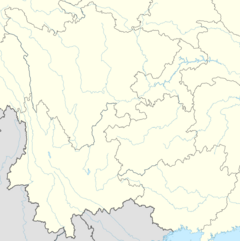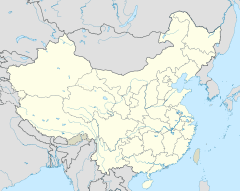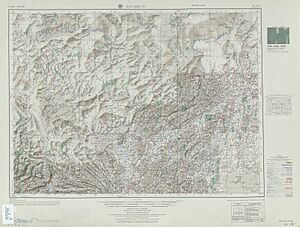Anshun facts for kids
Quick facts for kids
Anshun
安顺市
|
|
|---|---|
|
Prefecture-level city
|
|
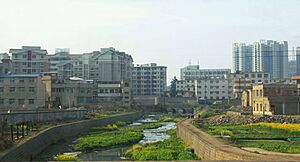 |
|
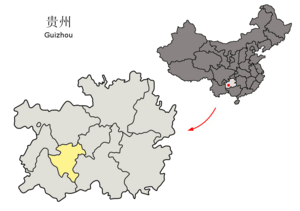
Location of Anshun City jurisdiction in Guizhou
|
|
| Country | People's Republic of China |
| Province | Guizhou |
| Municipal seat | Xixiu District |
| Area | |
| • Prefecture-level city | 9,269 km2 (3,579 sq mi) |
| • Urban | 1,724.24 km2 (665.73 sq mi) |
| • Metro | 1,724.24 km2 (665.73 sq mi) |
| Elevation | 1,380 m (4,530 ft) |
| Population
(2010 census)
|
|
| • Prefecture-level city | 2,297,339 |
| • Density | 247.852/km2 (641.93/sq mi) |
| • Urban | 765,313 |
| • Urban density | 443.8553/km2 (1,149.580/sq mi) |
| • Metro | 765,313 |
| • Metro density | 443.8553/km2 (1,149.580/sq mi) |
| GDP | |
| • Prefecture-level city | CN¥ 96.7 billion US$ 14.0 billion |
| • Per capita | CN¥ 39,160 US$ 5,678 |
| Time zone | UTC+8 (China Standard) |
| Area code(s) | 0851 |
| ISO 3166 code | CN-GZ-04 |
Anshun (simplified Chinese: 安顺; traditional Chinese: 安順; pinyin: Ānshùn) is a city in southwestern Guizhou province, southwest China. It is known for being close to the Huangguoshu Waterfall, which is the tallest waterfall in China. In 2010, about 2.3 million people lived in the Anshun area. The city itself had about 765,000 residents. Some cool places to visit nearby include the Long Gong Dragon Caves and the Getu River.
Contents
History of Anshun
Ancient Times: Yelang Kingdom
Long ago, during the Warring States period, the area where Anshun is now was part of an independent kingdom called Yelang. This kingdom was very large and important. People in Yelang had unique traditions like bamboo worship, cow totems, and even bullfights and dogfights!
Around 111 BCE, the powerful Han dynasty took over Yelang. Later, there was a small uprising to bring back the Yelang Kingdom, but it was stopped by the Han forces.
Changes Over Time
Through different Chinese dynasties like the Three Kingdoms period and the Jin dynasty, the Anshun area was divided into different counties.
During the Sui dynasty and later the Tang dynasty, the region was organized under different names. In 1292, under the Yuan dynasty, it became part of Puding Prefecture.
Ming and Qing Dynasties
The name "Anshun Prefecture" was first used during the early Ming dynasty. A famous Chinese traveler and geographer, Xu Xiake, visited Anshun in 1638.
In 1658, the area became part of the Qing dynasty. Around 1673, there was a big conflict called the Revolt of the Three Feudatories, and a lot of fighting happened in Anshun.
Modern Anshun
The old prefecture system ended in 1913 when the Republic of China was formed. Anshun then went through several changes in how it was governed.
Finally, in 2000, Anshun was officially reorganized into the "prefecture-level city" that it is today.
Geography and Climate
Anshun is located in a region with many karst formations. This means the landscape has cool features like caves and sinkholes, formed by water dissolving rock. The city is surrounded by other cities and prefectures in Guizhou.
The elevation in the Anshun area ranges from about 1,102 meters to 1,694 meters (about 3,615 to 5,558 feet) above sea level.
Anshun has a monsoon-influenced humid subtropical climate. This means it gets a lot of rain, especially from May to August. Winters are short, cool, and damp, while summers are very warm. The average temperature in January is about 4.5°C (40°F), and in July, it's about 22.0°C (71.6°F).
| Climate data for Anshun, elevation 1,431 m (4,695 ft), (1991–2020 normals, extremes 1971–2010) | |||||||||||||
|---|---|---|---|---|---|---|---|---|---|---|---|---|---|
| Month | Jan | Feb | Mar | Apr | May | Jun | Jul | Aug | Sep | Oct | Nov | Dec | Year |
| Record high °C (°F) | 21.9 (71.4) |
26.1 (79.0) |
31.8 (89.2) |
32.2 (90.0) |
33.4 (92.1) |
31.0 (87.8) |
32.4 (90.3) |
32.5 (90.5) |
31.7 (89.1) |
27.7 (81.9) |
24.0 (75.2) |
22.3 (72.1) |
33.4 (92.1) |
| Mean daily maximum °C (°F) | 7.5 (45.5) |
10.8 (51.4) |
15.4 (59.7) |
20.3 (68.5) |
22.9 (73.2) |
24.4 (75.9) |
25.9 (78.6) |
26.2 (79.2) |
23.5 (74.3) |
18.5 (65.3) |
14.9 (58.8) |
9.5 (49.1) |
18.3 (65.0) |
| Daily mean °C (°F) | 4.3 (39.7) |
6.9 (44.4) |
10.7 (51.3) |
15.5 (59.9) |
18.6 (65.5) |
20.6 (69.1) |
22.0 (71.6) |
21.9 (71.4) |
19.4 (66.9) |
15.1 (59.2) |
11.2 (52.2) |
6.2 (43.2) |
14.4 (57.9) |
| Mean daily minimum °C (°F) | 2.3 (36.1) |
4.3 (39.7) |
7.8 (46.0) |
12.3 (54.1) |
15.5 (59.9) |
18.1 (64.6) |
19.5 (67.1) |
19.0 (66.2) |
16.5 (61.7) |
12.8 (55.0) |
8.7 (47.7) |
3.9 (39.0) |
11.7 (53.1) |
| Record low °C (°F) | −5.2 (22.6) |
−4.8 (23.4) |
−5.9 (21.4) |
1.3 (34.3) |
6.7 (44.1) |
11.1 (52.0) |
10.7 (51.3) |
13.6 (56.5) |
8.5 (47.3) |
3.7 (38.7) |
−2.4 (27.7) |
−5.7 (21.7) |
−5.9 (21.4) |
| Average precipitation mm (inches) | 25.6 (1.01) |
21.3 (0.84) |
33.5 (1.32) |
67.7 (2.67) |
170.8 (6.72) |
297.3 (11.70) |
237.8 (9.36) |
171.8 (6.76) |
113.0 (4.45) |
95.5 (3.76) |
35.2 (1.39) |
19.0 (0.75) |
1,288.5 (50.73) |
| Average precipitation days (≥ 0.1 mm) | 16.1 | 13.4 | 15.3 | 14.4 | 17.3 | 18.7 | 17.5 | 15.0 | 12.5 | 16.1 | 11.7 | 12.9 | 180.9 |
| Average snowy days | 4.5 | 2.7 | 0.4 | 0 | 0 | 0 | 0 | 0 | 0 | 0 | 0.2 | 1.6 | 9.4 |
| Average relative humidity (%) | 84 | 81 | 78 | 76 | 76 | 81 | 81 | 79 | 78 | 82 | 80 | 81 | 80 |
| Mean monthly sunshine hours | 45.1 | 66.2 | 95.4 | 129.1 | 133.6 | 105.5 | 153.1 | 172.3 | 126.3 | 80.5 | 89.2 | 61.3 | 1,257.6 |
| Percent possible sunshine | 14 | 21 | 26 | 34 | 32 | 26 | 37 | 43 | 35 | 23 | 28 | 19 | 28 |
| Source 1: China Meteorological Administration | |||||||||||||
| Source 2: Weather China | |||||||||||||
How Anshun is Divided
Anshun is divided into different areas for local government. It has one main district, two counties, and three special "autonomous counties" for different ethnic groups.
| Map | |||||||||||||
|---|---|---|---|---|---|---|---|---|---|---|---|---|---|
The main parts of Anshun are:
- Xixiu District
- Pingba District
- Puding County
- Zhenning Buyei and Miao Autonomous County
- Guanling Buyei and Miao Autonomous County
- Ziyun Miao and Buyei Autonomous County
There are also special areas like the Anshun Economic Development Zone and the famous Huangguoshu Scenic Area.
Economy
In 2019, Anshun's total economic output (called GDP) was about 92.4 billion Chinese Yuan. This shows the city's economy is growing!
What Anshun Produces
Anshun is good at growing many crops. These include rice, yams, maize (corn), rapeseed, watermelons, and different vegetables. They also raise many animals like pigs, cows, and chickens.
The city makes both things for people to use (like detergent and mobile phones) and materials for other factories (like cement and aluminium).
Anshun is also becoming important in making airplanes, especially military ones. The Anshun Huangguoshu Airport is even used for testing new aircraft! The city government wants to make this industry even bigger in the future.
People of Anshun
In 2010, the population of Anshun was about 2,297,339 people. Most of the people (about 63.85%) are from the Han ethnic group.
However, Anshun is also home to many other ethnic groups. About 36.15% of the people belong to these different groups.
Tunpo People
A special group of people called the Tunpo People live in Anshun. Many of them live in Tianlong Tunbao town. They have kept their old traditions and ways of life for a very long time.
Getting Around Anshun
Trains
Anshun is connected by important railway lines. The Shanghai–Kunming railway passes through the city. There's also a high-speed train station, Anshun West railway station, which is part of the Shanghai–Kunming high-speed railway.
Airport
Anshun Huangguoshu Airport serves both regular travelers and military planes. You can fly from Anshun to cities like Chongqing, Guangzhou, and Beijing. Many people also fly to Guiyang Longdongbao International Airport and then take a bus to Anshun.
Roads
Major roads like the G60 Shanghai–Kunming Expressway and National Highway 320 go through Anshun, making it easy to travel by car or bus.
Education
The biggest college in Anshun is Anshun Normal University. It's a place where many students go to learn and prepare for their careers.
Famous Sites
Anshun has many exciting places to visit!
- Anshun Wenmiao: This is an old temple from the Ming dynasty. It was built to honor Confucius, a very famous Chinese philosopher.
- Huangguoshu Waterfall ("Yellow Fruit Tree Waterfall"): This is the largest waterfall in Asia! You can even walk behind it and see it from all sides.
- Getu River: This river flows through a mountainous area with amazing karst caves. You can visit Miao villages nearby and even climb 2,000 steps to the Chuangshang cave for a great view.
- Longgong Cave (龙宫洞; "Dragon Palace"): You can sail into this cave and see incredible rock formations called stalagmites and stalactites. There's also a waterfall at the cave's entrance.
- Tianlong Tunbao (屯堡) Ming Dynasty Town: This town is like stepping back in time! The people here have kept their old customs and even wear clothes from the Ming dynasty. Their houses are also very old.
- Tiantai Mountain: This mountain has an ancient temple complex that is over 400 years old. It's famous for its unique stone architecture.
- Zhongdong (中洞; Middle Cave): This is a truly unique village where about twenty families live inside a giant natural limestone cave! It's believed to be the only village in China that stays inside a cave all year round.
- Huajiang Canyon: This canyon is known as the "earth surface crack" because of its deep, narrow shape. You can find old writings carved into the cliffs here.
Folk Art
Anshun is famous for its traditional art forms.
- Anshun Batiks: This is a special art made by the Buyi minority group. Artists use wax to draw patterns on white cloth, then dye the cloth blue. When the wax is removed, the patterns appear in white, creating beautiful designs of flowers, birds, and other shapes. These batiks are used for clothes and other everyday items.
- Dixi Opera: This type of opera is sometimes called a "living fossil" because it's so old. The performers sing and dance, and they all wear special wooden masks. It's a very unique and ancient style of Chinese opera.
See also
 In Spanish: Anshun para niños
In Spanish: Anshun para niños



